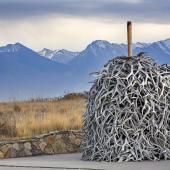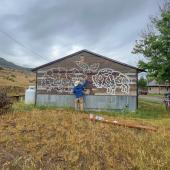The Tributary Fund
A fisherman, Buddhist monk, and a blonde meet on a riverbank in Inner Mongolia.
This scenario might sound punch-line perfect, but it actually represents the real-life collaboration between anglers, Mongolian monks, and the Bozeman-based conservation organization The Tributary Fund (TTF). Beginning in 2004, these seemingly disparate entities successfully partnered to protect the Earth’s largest salmonid, the behemoth taimen, and the watershed on which the fish—and people—depend. Today the blonde at the center of it all, TTF’s executive director Betsy Gaines Quammen, is working to replicate that achievement in her own backyard of Montana.
This new collaboration began last November in Great Falls. There, Quammen and TTF program director Susan Higgins met with over 20 Montana clergy and lay members representing a variety of communities, from Chester to Whitefish. The multidenominational dialogue examined how various Montana churches are addressing the environment and the tools needed to work as effective stewards of the land.
According to workshop participant Reverend Deborah Schmidt, who leads the United Methodist Church in Whitefish, “The reality is, many churches are interested in environmental stewardship, but pastors work like crazy. They need practical tips for introducing the connection between faith and environmental stewardship.” Some of these tips start with simply making churches more energy efficient or using fair-trade coffee at meetings. Schmidt returned to her church with plans for a five-acre community garden, which will eventually help feed low-income residents in Whitefish.
Though not itself a religious group, The Tributary Fund recognizes that when it comes to conservation, the most effective and lasting results happen when local communities are driving the effort. And whether it’s a fishery in Mongolia or grassland in eastern Montana that a community wants to protect, a lot of folks’ daily lives intersect in their respective places of worship. So in Mongolia, Buddhist leaders were the key liaisons between the American scientists and anglers working to conserve the taimen and local community members living in the watershed. Now as The Tributary Fund spearheads conservation projects in its home state, the nonprofit looks to a different group of religious leaders for dialogue and cooperation, in the group’s ongoing effort to join “culture and conservation.”
Says Quammen, “Religious beliefs are thousands of years old, but the issues we face today are ever emerging. The Tributary Fund helps religious leaders address modern conservation issues in their own communities, through the lenses of their own sacred texts and moral compasses.”
There will be challenges. Not all churches—nor all people—agree on some hefty issues, such as causes of climate change or the utility of Montana’s coal-to-liquid-fuel development. But as Deborah Schmidt says, “We are laying a foundation. There will be disagreements, but we are recognizing that part of our mission as clergy is to care for creation.” So the next chapter in The Tributary Fund’s work might look like this: Pastors, their communities, and a blonde collaborate to protect the matchless Montana landscape, and succeed. For more information about The Tributary Fund’s projects, visit: www.thetributaryfund.org.









